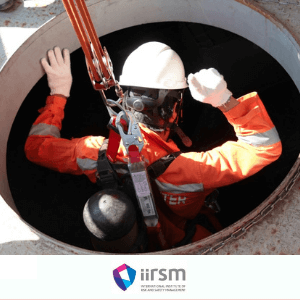Working in Confined Spaces Training
A confined space is defined as “any place in which by virtue of its enclosed nature, there arises a reasonably foreseeable specified risk”. Examples of working in confined spaces can be easily identifiable, such as storage tanks, silos, drains and sewers. There are also less obvious places that qualify as confined spaces, such as open top chambers, vats, combustion chambers and poorly ventilated or unventilated rooms. For an area of work to fit the criteria of being a “confined space”
- There are limitations to allow for access, either entry or exit
- The confined space is not designed to be used continuously
- The space allows enough space for a person to fit and work in
By the end of this course, you’ll be able to demonstrate your understanding of the control measures to be followed when working in or near to confined spaces as detailed in a safe working procedure. This includes
- what the law says.
- the potential hazards of working in confined spaces
- safe operating procedures
- emergency and rescue procedures
Who is this training course for?
This course is aimed at anyone who undertakes work in confined space or those who employ them. The course is also useful for those who plan or project manage work, where some or all of it takes place in confined spaces.
Dangers Associated with Working in Confined Space
Risk associated with confined space include
- A risk of serious injury from fire or explosion. This concerns what is known as ATEX which comes from a French expression which translates into English as Apperatus for use in explosive atmospheres.
- There is a risk of loss of consciousness due to increased body temperature
- Asphyxiation from gas, fumes, vapour or lack of oxygen.
- Asphyxiation is also possible from free flowing solids, drowning, or an inability to reach a breathable atmosphere due to entrapment by a free flowing solid. A free flowing solid is defined as a solid that can flow into the confined space like sand or gravel.
Safe Procedures and Reporting
The course details the main pieces of legislation that govern working in confined spaces including the Health and Safety at Work Act 1974 and The Confined Spaces Regulations 1997, and how they impact the responsibilities of each duty holder.
In this section, you will learn how to use the hazards you have identified to build out an effective risk assessment to implement. This will set out the roles and responsibilities of the different duty holders so that everyone understands the safe procedures they are responsible for. Safe procedures include:
- permitting and supervision
- competence and capability
- Cleaning, ventilation and air testing
- it would also involve special tools and lighting,
- personal protective equipment and harnesses respiratory protective equipment known as RPE
- communications and alarms.
Because of the potentially high-risk nature of working in confined space, suitable systems of communication and reporting procedures must be established. This is especially relevant where an emergency situation could occur. This course will give you the knowledge and direction to put a system in place to enable workers know how to respond in these situations and reporting measures to use as ongoing review monitoring.
Please note that this is an awareness course only so if your duties include working in confined spaces you also need further practical training. Please contact us if you would like more information on practical training.
| Course Content | Module |
| The Law | 1 |
| Confined Space and the Dangers? | 2 |
| Safe Procedures | 3 |
| Communication, Emergencies and Paperwork | 4 |
Course Assessment
Online assessment for this working in confined spaces awareness is carried out by a series of multiple choice questions. Candidates must answer 70% of the questions correctly to pass each module. We advise you to complete each module and answer the question before moving on to the next module. This provides a better learning experience because you will need to have knowledge from earlier modules to understand some of the material in the later modules. For those who complete the course successfully, a PDF certificate of the award is sent directly to your inbox. Hard copies of the award are available on request. The course takes 25 minutes of training to complete. This is course content only and does not cover the time it takes to answer questions.



